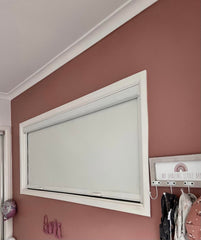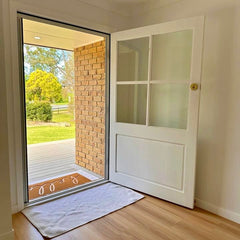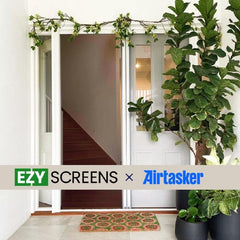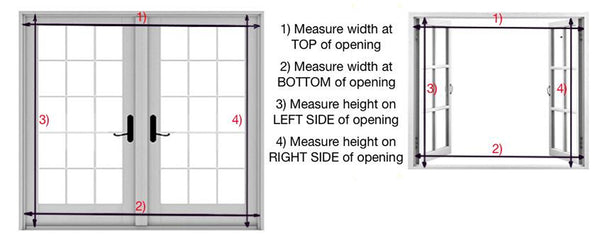As a homeowner, it’s likely that you’ve faced the task of cleaning your fly screens without wanting to go through the hassle of removing them from the window frame. The good news is: it’s possible! Not only does cleaning fly screens in place save time, but it reduces the risk of damage during the removal process. In this guide, we’ll walk you through our simple, step-by-step process of how to clean fly screens without removing them, so you can keep your home clean and your screens functioning perfectly.
Why Clean Fly Screens Without Removing Them?
Many homeowners find that learning how to clean fly screens without removing them is quick, easy, and avoids all the fuss - perfect for keeping the house clean without any unnecessary work.
Time-saving
Removing fly screens, cleaning them, and then reinstalling them can be a time-consuming task. By cleaning them in place, you save time and effort.
Avoiding Potential Damage
When you remove fly screens, there’s always a risk of bending or damaging them. Cleaning them while they’re still attached eliminates this risk. It also avoids the chance of incorrectly reinstalling the screens afterward, which could lead to issues with sealing and functionality.
Convenience
Fly screens are designed to be a protective barrier against insects and debris. Cleaning them in place makes the process more convenient, allowing you to get the job done without having to handle the screens more than necessary.
What You’ll Need to Clean Fly Screens Without Removing Them
Ready to learn how to clean a fly screen without removing it? Grab these tools first to make sure it goes smoothly:
-
Vacuum cleaner with brush attachment: Ideal for loosening and removing dust and dirt from the screen surface.
-
Soft-bristle brush: This is useful if you don’t have a vacuum cleaner with a brush attachment. It helps dislodge dirt and cobwebs gently.
-
Mild detergent: A gentle, non-abrasive detergent will clean the screen without causing damage.
-
Warm water: For mixing with the detergent to create a gentle cleaning solution, and for rinsing your cloth or sponge (after cleaning).
-
Microfibre cloth: A soft, absorbent cloth to wipe down the screens without scratching or damaging them.
-
A hose (optional): If you have easy access to an outdoor water source, a hose can help rinse the screens effectively.
-
A ladder (if needed): If your fly screens are in higher places, a sturdy ladder will help you reach them safely.
Step-by-Step Guide to Cleaning Fly Screens Without Removing Them
Step 1: Dust the Fly Screens
The first step in cleaning your fly screens is to remove any loose dirt, dust, and cobwebs that have accumulated on them. If you have a vacuum cleaner with a brush attachment, gently run the brush over the surface of the screen, starting from the top and working your way down. This will help dislodge any dirt and make the next steps more effective.
If you don’t have a vacuum cleaner with a brush attachment, a soft-bristle brush or even a paintbrush can work just as well. Use the brush to gently sweep over the surface of the screen and remove any loose debris. Be sure to brush both sides of the screen for the best results.
Step 2: Prepare a Gentle Cleaning Solution
Next, it’s time to prepare a cleaning solution. You’ll want to use a mild detergent to avoid damaging the mesh material. Add a few drops of mild dishwashing liquid or an eco-friendly cleaner to a bucket of warm water. Stir gently to create a soapy solution. Avoid using harsh chemicals or abrasive cleaners, as they can cause discolouration or damage to the screen over time.
Step 3: Wipe the Screens with a Damp Cloth
Once your cleaning solution is ready, dip a microfibre cloth into the warm water, wring out any excess water, and gently wipe down the fly screen. Work in small sections, starting at the top of the screen and moving down. Use circular motions to lift dirt and grime. Avoid soaking the screen or using excessive water, as too much moisture can seep into the frame and cause damage.
If your screens are particularly dirty, you should repeat this process until the entire surface is clean. For more stubborn dirt, a soft sponge or soft-bristle brush can be used to gently scrub the screen.
Step 4: Rinse and Dry the Fly Screens
After wiping the screen with the damp cloth, you’ll want to rinse it to remove any soap residue. You can do this by using another damp cloth, wiping down all areas of the screen that were cleaned. If your fly screens are outdoors and easily accessible, you can also rinse them using a garden hose. Just make sure the water pressure is not too high, as this could damage the screen.
After rinsing, let the fly screens air dry completely. Avoid using towels or cloths that could leave behind lint or fibres. If the screens are outside, the natural breeze will speed up the drying process. Be sure to let the screens dry fully before closing the windows to prevent any moisture buildup inside.
Tips to Keep Your Fly Screens Clean for Longer
Regular cleaning and maintenance can help keep your fly screens in good condition for longer. Here are our top tips to help you maintain your fly screens:
-
Dust your fly screens regularly to prevent dirt buildup. This can be done with a vacuum cleaner or a soft brush.
-
Keep the area around your windows clean. Wipe down window sills and remove any debris that falls onto the screens.
-
Stick to mild cleaning products to prevent damage. Harsh chemicals can break down the mesh or cause discolouration over time.
-
Regularly check for any tears or damage to the mesh. Small holes can be patched up quickly to avoid further damage.
Common Mistakes to Avoid When Cleaning Fly Screens
While cleaning fly screens is a simple task, there are a few common mistakes you’ll want to avoid:
-
Using abrasive cleaners: Harsh chemicals or abrasive scrubbing pads can damage the mesh, causing it to weaken or tear over time.
-
Excessive water: Too much water can seep into the frame and cause rust. Always use a damp cloth rather than soaking the screen.
-
Skipping regular maintenance: Neglecting regular cleaning can lead to a buildup of stubborn dirt that’s harder to remove later.
Need High-Quality Fly Screens for Your Home?
If your fly screens are worn out or you’re looking to upgrade, consider a durable, custom-made fly screen from Ezy Screens. With our high-quality screens, you can improve your home’s protection from insects while enjoying fresh air and natural light all year round.
Learn more about our screens.







